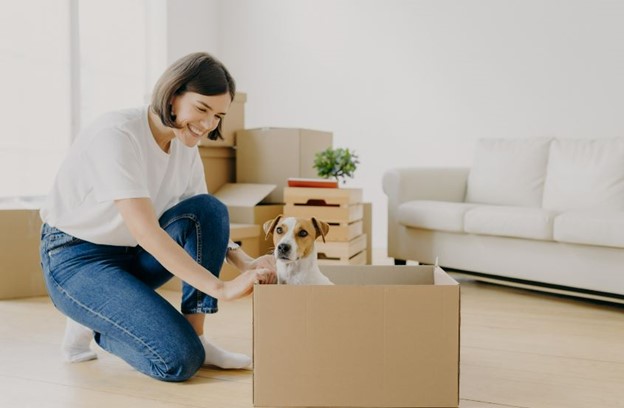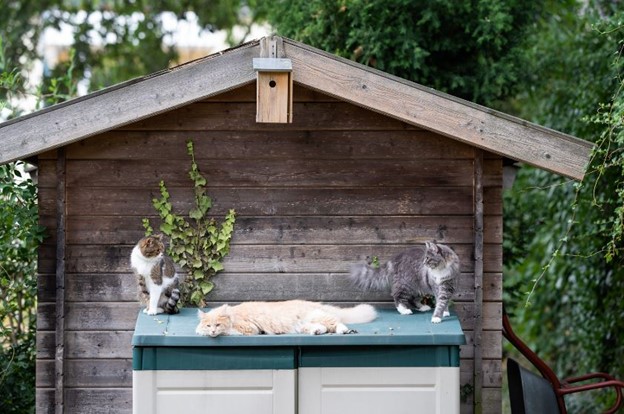
Its no secret that we love our pets, so when moving we want to ensure they are comfortable. Moving is hard on our furry family members and the transition is stressful. Its easy to get lost in the chaos of moving and to push our pets aside, however we have put together 5 steps to making moving with them successful.
Step 1: Location
Where you are moving has a huge impact on our pet’s lives. Whether you’re moving into an apartment or house can influence the quality of life for our pets. Cats and dogs have different needs. While cats are more likely to thrive in a variety of locations, dogs are a case-by-case basis.

Cats
Cats love to climb, so regardless of where you are moving be sure that there is room to create vertical spaces for your cats to climb on. If your cat is an outdoor cat be sure the location is suitable for them to go outside while keeping in mind traffic and wild animals that could be a risk to your cat. With outdoor cats we recommend creating a “catio” rather than letting your feline friends run free. A catio is like an outdoor cat kennel. It allows cats to get the stimulation from the outside world they love while keeping them safe.
Dogs
Unlike cats, dogs do not thrive in every living situation and it varies from dog to dog, down to their personality, age, and needs. Dogs with mobility issues will struggle to get around in a situation with many stairs. Plenty of dogs also have intense needs for exercise so living in an apartment or a home without a yard can be extremely difficult for them to get what they need. When moving with a dog, carefully consider their needs and how you, as an owner, can accommodate them.
Step 2: Planning
The best thing you can do for your pet is to keep their routine as normal as possible, however we know that can be hard so creating a plan can make all the difference. Cats particularly do not like change and you can help them to adjust to the process by beginning early and moving slow. This will be beneficial to your K9 family members as well. Seeing the boxes early will help them to get used to the process of packing. Another tip is to leave one room the same until the last minute. This way your animals have a safe space that stays constant. When it comes time to moving out, send your animal to a family member or close friend that they know that can ease the stress. Another solution is to keep them in a quiet room, so they won’t get scared or try to run while you’re in and out of the house.
Step 3: Prepare for Moving Day
It’s important to prepare your pet when the time comes for the big move. Many pets don’t spend a lot of time in a crate however, travelling in one makes things safer and less stressful for them as well as us. The weeks leading up to the move prepare your pets by slowly acclimating them to their crate. An easy way to do this is to feed them in their crates, starting with the door open and working towards it being locked. Using food and treats during crate time makes it a positive experience, which will make them want to go in their crates since they know there is a reward to follow. If your pet is small enough it is also beneficial to prepare them to be carried while in the crate. Taking short trips with your pet in their crates can help prepare them for the movement they will experience. Walking from one place inside to the next is a great start. Then you can practice by taking short car trips to help prepare for the actual move.

Step 4: Pet-Proofing & Settling In
You may think it’s all over once you get into your new space, however, your pets will need to adjust. Your first instinct may be to let your pet explore their new home but taking it slow is more beneficial. If you moved from a smaller space into a bigger one, it’s easy for your pets to become overwhelmed. Start by choosing a room that would be a dedicated home base for your pet. This is where their food and litter will be located. While they explore their home base you can spend time doing any pet proofing necessary – such as gates, safety locks on cabinets and moving toxic plants or food items to safe places – to reduce the risk of sickness or injury. Over time you can begin opening doors and keeping some closed to slow the process.
The key to moving with your pet successfully is to be patient and give them time, soon enough your new home will be theirs as well.
Find Your Purrfect Storage at Compass
Moving isn’t just stressful for our pets, it’s also stressful for us. Compass Self Storage is your one-stop-shop for all your storage needs.






